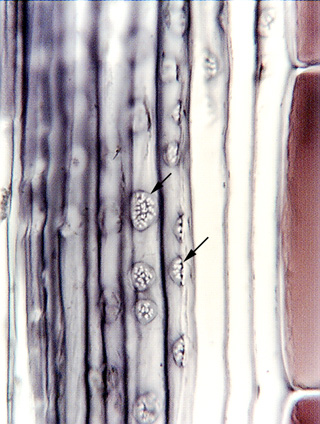 Fig.
8.2-4a. Longitudinal section of pine bark (Pinus
strobus). On the sieve tube members of angiosperms (flowering plants), the
sieve plates at the ends of the cells are large, but the sieve areas on the side
walls tend to be small and very difficult to see. Chances are, you will never
see them unless you become a phloem specialist.
Fig.
8.2-4a. Longitudinal section of pine bark (Pinus
strobus). On the sieve tube members of angiosperms (flowering plants), the
sieve plates at the ends of the cells are large, but the sieve areas on the side
walls tend to be small and very difficult to see. Chances are, you will never
see them unless you become a phloem specialist.
Conifers such as this pine, however, have sieve cells rather than sieve tube members, and these are characterized by having all sieve areas (arrows) of a more uniform size – the ones on the side walls are as large as those near the ends (sieve cells do not have sieve plates at their ends; that is the defining distinction between sieve cells and sieve tube members). Pine bark (secondary phloem) is excellent material for teaching about sieve areas: their sieve cells have many large sieve areas, and the sieve pores are even big enough to see here (the white dots in each sieve area).